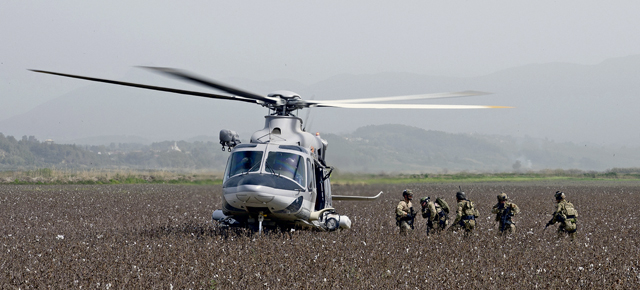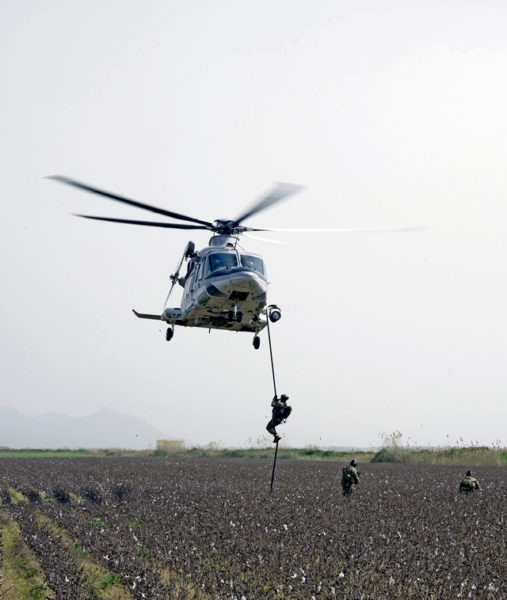ANDRAVIDA AIR BASE, Greece – Airmen assigned to the 4th Air Support Operations Group, Wiesbaden; the 4th Combat Training Squadron, Ramstein; the 7th Air Support Operations Squadron, Ft. Bliss, Texas; and Air National Guard Airmen in Poland supported U.S., Allied and partner nations during exercise INIOCHOS 22, held March 27 to April 7, 2022, at Andravida Air Base, Larissa and Argos in Greece.

INIOCHOS 22 is a Hellenic air force-sponsored operational and tactical level Field Training Exercise, hosted by the Hellenic Air Tactics Center at Greece’s fighter weapons school. The exercise is aimed at enhancing combat readiness, fighting capability, and the interoperability between the participating forces.
Tactical Air Control Party operators exercise mission command at the tactical edge to direct and synchronize air operations in support of NATO Allies and partners. This includes advising ground commanders on the capabilities and limitations of airpower, and the planning, requesting, and controlling of various air effects.
Joint Terminal Attack Con-trollers are specifically trained and certified TACP operators who provide terminal control of airpower, usually in the form of close air support.
The mission of the TACPs during the exercise is to support CAS engagements throughout the country of Greece by providing command and control, integration, and precision strike capabilities.

“In support of INIOCHOS 22, we have traveled to the four corners of Greece, working in the mountainous terrain as well as in the cities,” Senior Airman Dave Mehok, 4th Combat Training Squadron, JTAC qualified TACP operator.
TACP C2 relays information for CAS missions to the jets at the air base in Andravida from different locations, as well as the health and welfare of all TACPs throughout the country, explained TSgt. Austin Ballantine, 7 ASOS, TACP C2 Non-Commissioned Officer in Charge.
Training is vital between air and ground parties as there are not many links that exist. The TACP/NATO JTACs are there to assist.
TACP C2 is collecting data from the TACPs around the country, Greece, and channeling it to one specific point. This allows the information to be controlled and distributed to who needs to get it, explained Mehok.

“Our training is important because in a deployed environment we need to execute. In training, we can find any flaws or friction points in order to find solutions, so that when we deploy, we can support any NATO CAS aircraft and JTAC qualified personnel throughout the world,” added Ballantine.
There are many different CAS capabilities such as bombers, fighters, and Intelligence, Surveillance and Reconnaissance platforms. This exercise increases the operator’s interoperability between NATO partners specifically regarding close air support techniques, tactics and procedures.
“It is imperative for other countries to work with American JTACs so when they work with American aircraft, they have the same training we would get,” Ballantine said. “We train them while we work with them here in Greece. The same goes for NATO pilots, if they work with American JTACs they can expect the same results.”
The TACP operators showcase equipment they use to NATO counterparts, which is often different from their current capabilities. This allows our partners to learn and train on more equipment and overall increases interoperability across NATO.
During training and exercises like INIOCHOS, NATO operators have to persevere through language and training barriers to support the aircraft from multiple nations.
“Training in Greece has offered a unique opportunity with live ranges, excellent infrastructure and support facilities,” said Ballantine.
This isn’t Ballantine’s first mission in Greece. He participated in a CAS mission here eight years ago.
The proficiency levels since then have increased dramatically with the Greek pilots and the Greeks executing CAS,” said Ballantine. “I see a huge difference on how the Greeks can put on an exercise.”
The team explained how everyone has been very capable and each member has been utilized in many different roles during INIOCHOS 22.
“There are TACPs doing the TACP C2 mission – contacting aircraft directly, and TACPS that are doing the Precision Strike mission 100s of miles away,” said Ballantine. “We were able to arrive at many locations and immediately start executing. INIOCHOS proves that there are a variety of other mission sets that TACPs can do if given the opportunity.”


